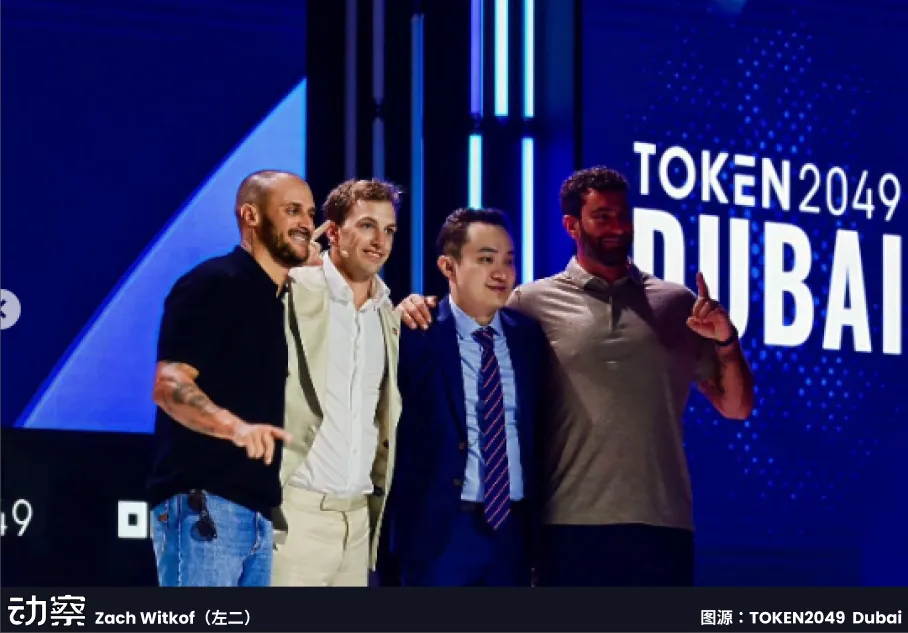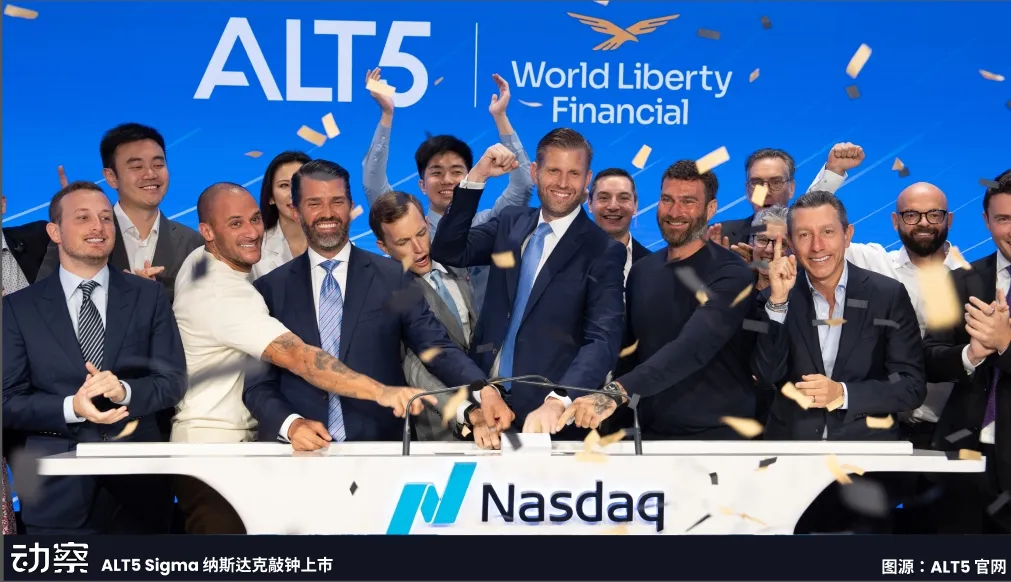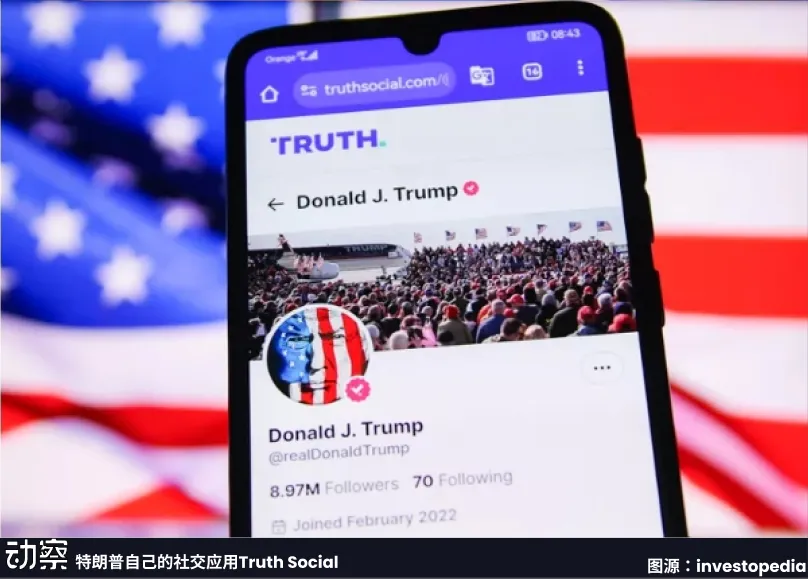$10 Billion Power-for-Money Deal: Trump Brings His Own Token to Wall Street
In August, amid routine announcements on Nasdaq, one fundraising deal made headlines: ALT5 Sigma announced an offering of up to 200 million common shares at $7.50 each (about 10 billion RMB), exchanged for WLFI tokens, and appointed Eric Trump, Donald Trump’s youngest son, to its board of directors.
Overnight, ALT5—a fintech company with just $20 million in annual revenue—transformed into the “Trump family’s listed treasury.” This wasn’t a typical capital raise; ALT5 used WLFI tokens swappable for shares and introduced the Trump-linked stablecoin USD1, bringing politically charged digital assets directly into the U.S. securities market.
WLFI (World Liberty Financial) isn’t a typical startup; it’s the Trump family’s own “political mint.”
Launched only two months before the U.S. election, WLFI, via its USD1 stablecoin, has brought in hundreds of millions of dollars for the Trump family’s enterprises in just a few months. In effect, ALT5 isn’t just adopting a stablecoin—it’s accessing an entire suite of political-financial instruments.
The central question: Is ALT5 actively raising capital, or selling “political dividend” tickets to join the Trump family’s wealth?
ALT5’s Shadow Heritage: The Triad of Influence
A company’s shareholder list often tells a more compelling story than its balance sheet.
ALT5’s equity structure is a puzzle pieced together by three powers: offshore capital, Wall Street funds, and political token interests. These factions intersect to make ALT5 look like both a financial technology firm and a grand political-financial experiment.
What makes ALT5 so notable is its political token shareholders: namely, Zach Witkoff and Eric Trump.
Eric Trump needs little introduction—he’s Donald Trump’s son and oversees the family’s crypto business empire. He’s now directly on ALT5’s board.
But special attention goes to Zach Witkoff: co-founder of the WLFI stablecoin and ALT5 chairman.
Just per his background, Zach Witkoff is no average founder. He’s the son of Steven Witkoff, a prominent Manhattan real estate developer who currently serves as the U.S. envoy for Middle East affairs.
The Witkoff family has spent decades in Manhattan real estate, controlling landmark properties. Steven Witkoff is deeply networked into both New York’s finance and politics.
The Trump family, too, rose from real estate, and Steven Witkoff has been close to Trump and his sons in New York’s property circles for years.
The Trump-Witkoff relationship boils down to this: old-money real estate ties plus political synergy. Zach and Eric’s partnership is far more than business—it’s a familial, strategic political-financial alliance.

Eric Trump brings the political network of his family; Zach Witkoff acts as the executor, making the Trump family’s vision real in financial markets. Together, they are the bridge between political power and fintech ambition.
This partnership almost guarantees ALT5’s future path grows sharply more political—not just commercial expansion, but arming itself with financial tools for the 2025–2028 U.S. political cycle. In many ways, ALT5 now operates as part of the Trump family’s “financial arsenal.”
Let’s turn to ALT5’s major shareholders, like Clover Crest Bahamas Ltd., an offshore company registered in the Bahamas with an 11% stake.
The Bahamas is known for being a tax haven—home to countless companies and wealthy individuals for its lenient tax laws and minimal regulatory scrutiny.
Simply put, Clover Crest is the Trump family’s covert channel, discreetly funneling capital into ALT5 and mitigating risk when needed.
The next shareholder force is Wall Street—think global fund giants like Vanguard. These funds are commonly held by millions around the world through broad index funds.
Vanguard’s position in ALT5 is minor, likely a passive holding, but its very presence carries “legitimacy.” When investors see “Vanguard” among shareholders, it signals regulatory confidence and trustworthiness. That’s the power of institutional endorsement.
Each of these factions brings distinct logic: Offshore capital offers discreet funding routes, Wall Street money lends credibility and a compliant face, while the political token group crafts the story and strategic direction, propelling ALT5 onto the global stablecoin stage.
Together, they make ALT5 both polished and risky.
On the surface, ALT5 is a compliant fintech firm. Underneath, it serves as a “Trojan Horse for stablecoins”—a vessel for political and financial ambitions cleverly cloaked in regulatory respectability.
FinTech’s Facade—What Lies Behind the Door of Compliance?
On paper, ALT5 is a model fintech company. It holds every necessary license, offers payment gateways, OTC trading, custody services, and white-label exchange solutions. With $20 million in annual revenues and a near-50% Gross Margin, it ranks as an industry leader in crypto payments. Its compliance, transparency, and clean numbers even surpass many legacy payment companies.
But what catapulted ALT5 from niche FinTech to global intrigue was its $1.5 billion fundraising in August 2025. Overnight, it was no longer just an API provider—it became the “Nasdaq-listed entity” for Trump’s WLFI stablecoin.
This signaled a transformation: ALT5 was now the linchpin for the globalization of stablecoins.
Why call it a “backdoor”? The answer is simple.
First, surface identity provides regulatory cover. If WLFI tried to enter global payments networks directly, central banks and regulators would be barriers.
But ALT5 has the fintech licenses to act as a “payment gateway provider.” Regulators see a textbook-compliant fintech operation—not a politically loaded stablecoin.
Second, there’s a discreet route for cross-border settlements. ALT5 Pay’s API lets merchants accept BTC, USDT, or other crypto payments, then auto-convert them to dollars or euros behind the scenes.
If WLFI/USD1 joins the mix, merchants and consumers may never realize their transactions run through a Trump-backed stablecoin. It looks like “payment tech,” but actually embeds stablecoin adoption.
Third, global networks are now tightly woven in. ALT5 bridges the Lightning Network with stablecoin payments, vastly increasing speed and efficiency versus SWIFT-based legacy systems.
For emerging markets eager for dollars but lacking direct Wall Street access, ALT5 becomes a hidden express lane. With it, WLFI can swiftly permeate global trading venues with minimal resistance.

This strategic $1.5 billion funding isn’t just growth capital—it’s an investment in building global payment rails for WLFI.
ALT5 can always reassure regulators: “We’re simply a compliant API payment company.” But in the shadows, its interfaces may be conduits for stablecoins escaping the legacy financial system.
This dual narrative makes ALT5 the archetype of the “FinTech front.” To outsiders, it’s clean and professional; inside, it’s climbing to strategic prominence as a vital piece in stablecoin globalization.
This is why WLFI jumped so quickly from political buzzword to financial utility: it discovered ALT5 as the “legal backdoor.”
Once the compliant facade is thick enough, stablecoins can quietly permeate business and consumer transactions, and regulators may not notice until the floodgates are already open.
Trump’s Shadow Dollar Empire
ALT5 is only the beginning; underneath lies the Trump family’s plan for a parallel dollar system.
They’re melding politics, media, finance, and mining into one machine: using voter communities as the entry, monetizing attention, building compliance channels, and using mining power and Bitcoin reserves as support.
On the surface, it’s a series of funding rounds and launches; in essence, it’s a redesign of the dollar pathway—distinct entry, pricing, clearing, and reserve strategies.
The real provocation isn’t “decentralization,” but a new distribution of power: who defines on-chain dollar value, who spins the asset narrative, who reports it in ledgers, who controls underlying credit. This isn’t a single coin experiment—it’s a shadow Wall Street built beside the original.
At the political layer, the Trump version of stablecoin USD1 is the financialization of political allegiance.
USDT and USDC represent market and institutional interests—USDT dominates exchange liquidity, USDC enjoys Wall Street’s regulatory trust. USD1, however, is positioned as the stablecoin for Trump supporters.
This currency is overtly political—not focused on “payment efficiency” or “lowering cross-border costs,” but on fusing political identity with financial assets.
For Trump, USD1 is a perpetual fundraising pool, a social cohesion tool, and an extension of the dollar narrative. If USDT is for traders and USDC for Wall Street, USD1 is Trump’s dollar—turning party loyalty into a functioning financial ecosystem.
This setup is both risky and explosive. Risks include: if the political landscape shifts or legal intervention strikes, USD1 may be branded “unlawful.” Potential: the coin doesn’t need to build a new market—it can instantly mobilize millions of loyal followers and forge a powerful monetary community.
In the media realm—from Truth Social to meme coins—attention is currency.
If USD1 is the Trump family’s “financial weapon,” then media is the “gunpowder.” Without attention and narrative, a stablecoin design is just numbers in a ledger.
The family’s first media piece is Trump Media & Technology Group (TMTG), whose Truth Social is now the conservative community’s echo chamber.
On Truth Social, political activism and information delivery are tightly knit—every Trump message spreads instantly.

Meme coins like $TRUMP and $MELANIA are experiments in converting attention straight into monetary value.
This fusion creates a closed monetization loop: political events drive conversation → buzz builds on Truth Social; meme coins act as emotion outlets, quickly attracting speculative capital; TMTG’s treasury and USD1 stablecoin absorb the funds, turning short-term hype into lasting assets.
Financially, this is where ALT5 reports tokens in U.S. financial statements.
The last puzzle piece is mining and Bitcoin reserves.
The Trump-backed American Bitcoin pursues mergers and reverse takeovers, targeting Asian and North American assets. In North America, it directly controls mining capacity and energy prices.
The Trump ecosystem’s capital base (real estate, energy, finance) has deep roots in oil, infrastructure, and utilities; adding BTC mining to the family’s portfolio is a natural extension. This brings mining, capital, and secondary markets into a tightly integrated network.
Ultimately, the Trump crypto empire is a “shadow dollar coup”—a radical challenge to Wall Street’s traditional order.
Politics brings identity and funding; media supplies awareness and cash flow; finance registers tokens in public reports; mining anchors the system with hash power and Bitcoin reserves.
Conclusion
The real risk isn’t in USD1 itself, but in the fact that an underground dollar parallel is already running—operated not by the Fed or Goldman, but the Trump family.
ALT5 is the gateway, WLFI/USD1 is the banner, Truth Social and meme coins are the amplifiers, and Bitcoin mining is the foundation. On the surface, they look disconnected; in reality, they interlock into a political-financial machine working in the shadows.
This machine’s ambition isn’t to create a “compliant USDT,” but to combine finance and politics with WLFI: turning payments into votes, capital flows into voter streams, and making the capital markets reflect the election battleground.
If Wall Street is the dollar’s official palace, the Trump family is quietly building a hidden channel—redirecting the dollar’s flow into its own parallel empire.
Disclaimer:
- This article is reprinted from [Lin Wanwan], with copyright belonging to the original author [Lin Wanwan]. For reprint disputes, please contact the Gate Learn team for resolution.
- Disclaimer: The opinions and views expressed in this article are solely those of the author and do not constitute investment advice.
- All other language versions are translated by the Gate Learn team. Unless explicitly referencing Gate, reproduction, distribution, or plagiarism of any translated article is strictly prohibited.
Related Articles

Solana Need L2s And Appchains?

The Future of Cross-Chain Bridges: Full-Chain Interoperability Becomes Inevitable, Liquidity Bridges Will Decline

Sui: How are users leveraging its speed, security, & scalability?

Navigating the Zero Knowledge Landscape

What is Tronscan and How Can You Use it in 2025?
